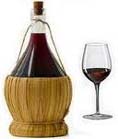Wine Labels
from Italian Traditional Food
Wine Labels a collectable
item
Check out these great Italian ideas at Amazon for Italian food and kitchen ideas.
Wine labels or bottle tickets – to give them their original name – came into
being at the beginning of the 18th century with the advent of the decanter.
Early Wine Labels
None of the early ones, made of wood, bone or parchment, seem to have survived. They were
usually attached, as their name suggests, to the necks of the coloured glass bottles in which the wine was “binned”
to give an indication of the contents.
The Development of Wine Labels
By 1730, flint glass decanters were in use in many a well-to-do
household, and bottle tickets of silver, pewter and enamel were soon produced in quantity. Their inscriptions make
fascinating reading, as well as providing an indisputable account of the drinking habits of our ancestors.
Among the more usual Madeira, Lisbon, sherry and port labels, you may find “shrub”, a potent
cordial of rum and fruit juice popular from 1790; “mountain”, a sweet dessert wine,; “tent”, a red Spanish wine
still imported for Communion purposes; and “Bucellas”, a white wine from Portugal, greatly drunk during the 18th
and 19th centuries. You may even come across “mum”, a cordial of exceptional strength from Germany, containing
eggs, herbs and horseradish among other enticing ingredients.
Silver Wine Labels
Specialist collectors have noted over 1,500 different commodities on bottle tickets, though it
must be admitted that these include creams, lotions and toilet bottles as well as wines and spirits.
Most people collect the silver bottle tickets. They can be dated according to the hallmarks, and
if you intend collecting seriously, its worth learning about these even though the marks on the earlier wine labels may not be complete.
This was largely due to the confusion over the Duty Act of 1784, which placed a tax of sixpence
an ounce on silver, but did not mention bottle tickets in the list of dutiable items. To be on the safe, some
silversmiths had theirs stamped with the King’s head to show the duty had been paid. After 1790 they were included
in the list and the position is much clearer.
Wine Label Styles
Another guide is the style of the wine
label. The first ones were rectangular in shape, either narrow or broad; or crescent-shaped with very little
decoration.
Then famous silversmiths such as Hester Bateman joined the field, and in 1794 labels were
die-stamped instead of hand-cut, and elaborate designs became popular. Escutcheons or shields, goblets and vine
leaves soon followed, and the eye-shaped and “kidney” labels made their appearance.
You’ll be very lucky if you find an original Battersea enamel label, but many pretty ones were
made in Staffordshire and decorated with posies of flowers and blue-ringed eyelet holes. Then, sadly, in 1860, an
Act of Parliament permitted the sale of wine in single bottles and put them all out of fashion.
Read more Italian traditional food related articles here

Copyright © 2009 - . All Rights Reserved
Worldwide. Italian Traditional Food
You may not reprint articles from this website
without the written permission of the site owner.
Disclaimer: Articles on this
Website are provided for information purposes only. Italiantraditionalfood.com does not accept any responsibility
or liability for the use or misuse of the article content on this site or reliance by any person on the site's
contents.
| 


 Digg
Digg Stumbleupon
Stumbleupon Google Bookmarks
Google Bookmarks Delicious
Delicious Twitter
Twitter Facebook
Facebook Yahoo My Web
Yahoo My Web Reddit
Reddit